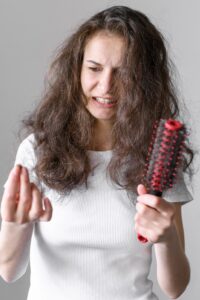Table of Contents
-
Introduction: Understanding Hair Breakage
-
What Causes Hair Breakage?
-
2.1. Heat Damage
-
2.2. Chemical Damage
-
2.3. Over-Brushing and Tension
-
2.4. Lack of Moisture
-
2.5. Poor Diet and Health
-
2.6. Environmental Factors
-
-
How to Prevent Hair Breakage
-
3.1. Use Heat Protectants
-
3.2. Limit Chemical Treatments
-
3.3. Gentle Hair Care Routine
-
3.4. Moisturize and Nourish Your Hair
-
3.5. Healthy Diet for Healthy Hair
-
3.6. Protect Hair from the Environment
-
-
The Role of Hair Products in Preventing Breakage
-
Natural Remedies for Stronger Hair
-
Summary and Final Thoughts
-
Call to Action: Embrace Healthier Hair Today!
Introduction: Understanding Hair Breakage
Hair breakage is a common problem many people face at some point in their lives. Whether you’re noticing more strands on your brush or dealing with split ends that seem impossible to tame, hair breakage can be frustrating and discouraging. But what exactly causes hair breakage, and more importantly, how can we prevent it?
In this blog, we’ll take a deep dive into the top causes of hair breakage and offer practical solutions to keep your locks healthy and strong. By understanding the reasons behind hair breakage and implementing simple hair care practices, you can transform your hair into its best condition.
What Causes Hair Breakage?

To address hair breakage, we first need to understand its causes. Several factors can contribute to the weakening of hair strands, leading to breakage. Here’s a closer look at the primary culprits:
2.1. Heat Damage
One of the most common causes of hair breakage is excessive heat. Hair styling tools like flat irons, curling irons, and blow dryers can damage the hair cuticle (the outermost layer of the hair). Heat can strip moisture from the hair, leaving it brittle and prone to breaking. When used frequently without protection, heat styling can weaken hair over time.
Story:
Maria, a longtime lover of straightened hair, noticed that her hair had become thinner and more fragile. She realized that using a flat iron daily without a heat protectant led to hair breakage and split ends. After switching to a heat protectant and reducing the use of styling tools, she saw remarkable improvements in her hair’s strength.
2.2. Chemical Damage
Hair coloring, perming, and relaxing treatments can also lead to hair breakage. These chemical processes alter the hair structure and can make hair more porous and fragile. Constant exposure to chemicals weakens the bonds in your hair, making it easier for it to break.
Story:
Sophia loved experimenting with hair color but noticed that her once thick hair became weak and prone to breakage. After visiting a professional, she learned that the constant use of hair dye was damaging the integrity of her hair, causing it to break more easily. Switching to less damaging dyes and spacing out treatments helped her hair regain its strength.
2.3. Over-Brushing and Tension
Brushing hair too often or using the wrong type of brush can cause hair breakage. When hair is wet, it is more fragile, and brushing it aggressively can cause strands to snap. Additionally, tight hairstyles like ponytails or braids can create tension, leading to hair breakage near the scalp.
Story:
Lily had a habit of brushing her hair a few times a day, especially when it was wet, believing that it kept her hair smooth. However, she soon noticed her hair thinning around her hairline. She realized that over-brushing and pulling her hair into tight ponytails caused breakage. Now, she uses a wide-toothed comb and avoids tight styles.
2.4. Lack of Moisture
Dry hair is more susceptible to breakage. Without enough moisture, hair becomes brittle and lacks the elasticity needed to withstand everyday stresses like brushing, styling, and environmental exposure.
Story:
Emma’s hair was always dry, and no matter how many leave-in conditioners she tried, it still seemed to break easily. After consulting with a professional, she learned that her hair lacked essential moisture. She started incorporating deep conditioning treatments and hydrating oils, which greatly improved her hair’s strength.
2.5. Poor Diet and Health
A poor diet can lead to hair that lacks the nutrients necessary for growth and strength. Hair requires a variety of vitamins and minerals like biotin, zinc, and vitamin D to stay healthy. A deficiency in these nutrients can contribute to hair breakage and thinning.
Story:
James had noticed his hair thinning, and after some research, he discovered that his diet was lacking in essential vitamins. He started taking supplements and made healthier choices, including incorporating more fruits, vegetables, and protein into his meals. Over time, his hair began to feel thicker and less prone to breakage.
2.6. Environmental Factors
Environmental exposure to harsh weather conditions, pollution, and UV rays can damage hair. Wind, sun, and pollution can strip moisture from the hair and weaken it, causing it to break more easily.
Story:
Jessica loved spending time outdoors, but she noticed her hair was becoming dry and brittle after long days in the sun. She began wearing hats and using UV protection sprays for hair, which significantly reduced the damage and helped protect her hair from environmental stressors.
How to Prevent Hair Breakage

Source – https://www.freepik.com/free-photos-vectors/hair-breakage
Now that we understand the causes of hair breakage, let’s dive into how to prevent it. There are several steps you can take to keep your hair strong, healthy, and breakage-free.
3.1. Use Heat Protectants
If you can’t avoid heat styling, always use a heat protectant. Heat protectants form a barrier between your hair and styling tools, helping to minimize the damage caused by high temperatures. Choose one that is suitable for your hair type and style preferences.
3.2. Limit Chemical Treatments
While occasional color or chemical treatments may be fine, overdoing them can weaken your hair. Consider going for natural alternatives when possible and take breaks between treatments to allow your hair to recover.
3.3. Gentle Hair Care Routine
Avoid aggressive brushing, especially when your hair is wet. Use a wide-toothed comb or a detangling brush and be gentle. Also, avoid pulling your hair into tight styles that create tension. Give your hair the time and care it needs to stay strong.
3.4. Moisturize and Nourish Your Hair
Regularly use deep conditioning treatments to hydrate your hair and replenish lost moisture. Look for hair masks and oils that are rich in natural ingredients like argan oil, coconut oil, or shea butter. These ingredients help strengthen and protect the hair from breakage.
3.5. Healthy Diet for Healthy Hair
Eating a well-balanced diet rich in vitamins and minerals is essential for maintaining healthy hair. Focus on consuming foods high in biotin, zinc, omega-3 fatty acids, and proteins. Supplements can also help fill in any nutritional gaps.
3.6. Protect Hair from the Environment
When going outside, protect your hair from environmental damage by wearing hats or scarves. UV rays can weaken hair over time, so look for hair products that offer UV protection. Also, keep your hair protected from harsh wind and cold temperatures.
The Role of Hair Products in Preventing Breakage

Source – https://www.freepik.com/free-photo/medium-shot-woman-using-dry-shampoo-home_60047797.htm#fromView=search&page=1&position=3&uuid=8b926710-e816-4e81-b2ae-dc8e9f1a7abe&query=Hair+Products+in+Preventing+Breakage
The right hair care products can make a significant difference in preventing hair breakage. From shampoos to oils, the products you use should cater to your hair’s specific needs.
Look for products that are sulfate-free, as sulfates can strip natural oils from the hair. Additionally, nourishing oils like argan and jojoba oil can hydrate and strengthen your hair, reducing the likelihood of breakage.
Natural Remedies for Stronger Hair

In addition to commercial products, several nautral remedies can help strengthen and nourish your hair. For example:
-
Coconut Oil: Rich in fatty acids, it helps reduce protein loss and adds moisture.
-
Aloe Vera: Known for its soothing properties, aloe vera can help repair hair and reduce scalp irritation.
-
Avocado: Packed with vitamins, it helps nourish dry and damaged hair.
Summary and Final Thoughts
Hair breakage can be frustrating, but it’s not something you have to live with. By understanding the causes of hair breakage and taking steps to prevent it, you can restore strength and vitality to your hair. From reducing heat exposure to nourishing your strands with moisture, there are plenty of ways to keep your hair healthy and breakage-free.
Call to Action: Embrace Healthier Hair Today!
Are you ready to start your journey to stronger, healthier hair? Begin by evaluating your hair care routine and incorporating some of the tips we discussed. Whether you’re using heat protectants, nourishing oils, or eating a more balanced diet, every small change will make a difference. Take charge of your hair care today and say goodbye to breakage!

